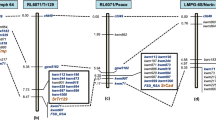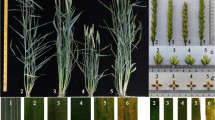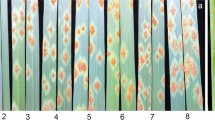Abstract
Thinopyrum species are potential sources of disease resistance for wheat. Thinopyrum bessarabicum is a well-known source of salt tolerance, but there are very few reports of rust resistance being transferred from this species to wheat. Here, we report wheat-Th. bessarabicum–derived stem rust and stripe rust–resistant doubled haploid (DH) lines and characterized using molecular markers and cytogenetic analyses. We used sequential non-denaturing fluorescence in situ hybridization (ND-FISH) and genomic in situ hybridization (GISH) to determine their genomic compositions. Cytological results were validated by molecular analysis using genome-specific PCR markers. These lines were either alien additions, partial diploids, or partial amphidiploids. Line DH9 was a disomic addition line carrying chromosome 4Jb whereas DH1 was a double disomic addition line for chromosomes 6Jb and 7Jb. Lines DH7 and DH8 were partial diploids that were cytologically unstable due to having ph1ph1 genotype. DH7 also had a pair of T6BL-6JbL.6JbS translocated chromosomes and was monosomic for a T5DS-5JbS.5JbL translocation. The size of the translocated alien segment in chromosome T5DS-5JbS.5JbL was L+(0–0.42)S, whereas the size of wheat chromatin in chromosome T6BL-6JbL.6JbS was S+(0–0.85)L. Lines DH5 (2n = 50) and DH11 (2n = 54) were partial amphidiploids with eight and 12 Th. bessarabicum chromosomes, respectively. Lines DH7, DH8, and DH11 expressed an intermediate level of resistance to stem rust with infection types (ITs) varying from 1+2 to 23-, whereas they were immune or near-immune (IT 0 to 0) to stripe rust. Comparison of the rust reactions, genome compositions, and molecular markers of the DH lines along with their parents indicated that the Thinopyrum chromosome conferring resistance to both rusts was 2Jb.



Similar content being viewed by others
References
Able JA, Langridge P (2006) Wild sex in the grasses. Trends in Plant Sci 11:261–263
Allahdoo M, Siahsar B, Hassani HS, Pour A, Nazhad N (2009) The identification of Eb chromosomes in tritipyrum primary lines using random and semi random primers. Trakia J Sci 7:1–6
Ardalani S, Mirzaghaderi G, Badakhshan H (2016) A Robertsonian translocation from Thinopyrum bessarabicum into bread wheat confers high iron and zinc contents. Plant Breed 135:286–290
Bao Y, Wu X, Zhang C, Li X, He F, Qi X, Wang H (2014) Chromosomal constitutions and reactions to powdery mildew and stripe rust of four novel wheat–Thinopyrum intermedium partial amphiploids. J Genet Genomics 41:663–666
Cai X, Jones S, Murray T, Weber W (2001) Molecular cytogenetic characterization of Thinopyrum genomes conferring perennial growth habit in wheat-Thinopyrum amphiploids. Plant Breed 120:21–26
Chen H, Qian B, Zhuang L, Chen Q, Feng G, Pei Z, Qi Z, Chen P, Liu D (2007) Molecular marker analysis on common wheat landrace Chinese Spring alien chromosome lines derived from Thinopyrum bessarabicum Love. Acta Agron Sin 4:1232–1239
Dewey DR (1984) The genomic system of classification as a guide to intergeneric hybridization with the perennial Triticeae. Gene Manipulation in Plant Improvement, Springer, Boston, pp 209–279
Du P, Zhuang L, Wang Y, Yuan L, Wang Q, Wang D, Dawadondup Tan L, Shen J, Xu H (2016) Development of oligonucleotides and multiplex probes for quick and accurate identification of wheat and Thinopyrum bessarabicum chromosomes. Genome 60:93–103
Dubcovsky J, Dvorak J (2007) Genome plasticity a key factor in the success of polyploid wheat under domestication. Sci 316:1862–1866
Friebe B, Jiang J, Raupp W, McIntosh R, Gill BS (1996) Characterization of wheat-alien translocations conferring resistance to diseases and pests: current status. Euphytica 91:59–87
Fu S, Lv Z, Qi B, Guo X, Li J, Liu B, Han F (2012) Molecular cytogenetic characterization of wheat–Thinopyrum elongatum addition, substitution and translocation lines with a novel source of resistance to wheat Fusarium head blight. J Genet Genomics 39:103–110
Geiger HH (2009) Doubled haploids. In: Handbook of maize. Springer, New York, pp 641–657
Ghazali S, Mirzaghaderi G, Majdi M (2015) Production of a novel Robertsonian translocation from Thinopyrum bessarabicum into bread wheat. Cytol Genet+ 49:378-381
Gorham J, McDonnell E, Budrewicz E, Jones RW (1985) Salt tolerance in the Triticeae: growth and solute accumulation in leaves of Thinopyrum bessarabicum. J Exp Bot 36:1021–1031
Grewal S, Yang C, Edwards SH, Scholefield D, Ashling S, Burridge AJ, King IP, King J (2018) Characterisation of Thinopyrum bessarabicum chromosomes through genome-wide introgressions into wheat. Theor Appl Genet 131:389–406
Han F, Fedak G, Benabdelmouna A, Armstrong K, Ouellet T (2003) Characterization of six wheat× Thinopyrum intermedium derivatives by GISH, RFLP, and multicolor GISH. Genome 46:490–495
Han F, Liu B, Fedak G, Liu Z (2004) Genomic constitution and variation in five partial amphiploids of wheat–Thinopyrum intermedium as revealed by GISH, multicolor GISH and seed storage protein analysis. Theor Appl Genet 109:1070–1076
Hu LJ, Li GR, Zeng ZX, Chang ZJ, Liu C, Yang ZJ (2011) Molecular characterization of a wheat-Thinopyrum ponticum partial amphiploid and its derived substitution line for resistance to stripe rust. J Appl Genet 52:279–285
Jauhar PP, Peterson TS (2006) Cytological analyses of hybrids and derivatives of hybrids between durum wheat and Thinopyrum bessarabicum, using multicolour fluorescent GISH. Plant Breed 125:19–26
Jauhar PP, Peterson TS (2013) Synthesis and characterization of advanced durum wheat hybrids and addition lines with Thinopyrum chromosomes. J Hered 104:428–436
Jauhar PP, Peterson TS, Xu SS (2009) Cytogenetic and molecular characterization of a durum alien disomic addition line with enhanced tolerance to Fusarium head blight. Genome 52:467–483
Jensen K, Griffin G (1994) Resistance of diploid Triticeae species and accessions to the Columbia root-knot nematode, Meloidogyne chitwoodi. J Nematol 26:635
Kasha K, Kao K (1970) High frequency haploid production in barley (Hordeum vulgare L.). Nature 225:874–876
Kato A (1999) Air drying method using nitrous oxide for chromosome counting in maize. Biotech Histochem 74:160–166
King I, Purdie K, Rezanoor H, Koebner R, Miller T, Reader S, Nicholson P (1993) Characterization of Thinopyrum bessarabicum chromosome segments in wheat using random amplified polymorphic DNAs (RAPDs) and genomic in situ hybridization. Theor Appl Genet 86:895–900
King IP, Forster BP, Law CC, Cant KA, Orford SE, Gorham J, Reader S, Miller TE (1997) Introgression of salt-tolerance genes from Thinopyrum bessarabicum into wheat. New Phytol 137:75–81
Lang T, La S, Li B, Yu Z, Chen Q, Li J, Yang E, Li G, Yang Z (2018) Precise identification of wheat–Thinopyrum intermedium translocation chromosomes carrying resistance to wheat stripe rust in line Z4 and its derived progenies. Genome 61:177–185
Larkin P, Banks P, Lagudah E, Appels R, Xiao C, Zhiyong X, Ohm H, McIntosh R (1995) Disomic Thinopyrum intermedium addition lines in wheat with barley yellow dwarf virus resistance and with rust resistances. Genome 38:385–394
Laurie D, Bennett M (1986) Wheat× maize hybridization. Can J Genet Cytol 28:313–316
Li H, Wang X (2009) Thinopyrum ponticum and Th. intermedium: the promising source of resistance to fungal and viral diseases of wheat. J Genet Genomics 36:557–565
Linc G, Gaál E, Molnár I, Icsó D, Badaeva E, Molnár-Láng M (2017) Molecular cytogenetic (FISH) and genome analysis of diploid wheatgrasses and their phylogenetic relationship. PLoS One 12:1–18
Liu J, Chang Z, Zhang X, Yang Z, Li X, Jia J, Zhan H, Guo H, Wang J (2013) Putative Thinopyrum intermedium-derived stripe rust resistance gene Yr50 maps on wheat chromosome arm 4BL. Theore Appl Genet 126:265–274
McIntosh RA, Wellings CR, Park RF (1995) Wheat rusts: an atlas of resistance genes. CSIRO Publication, Melbourne
Mirzaghaderi G, Shahsevand HH, Karimzadeh G (2010) C-banded karyotype of Thinopyrum bessarabicum and identification of its chromosomes in wheat background. Genet Resour Crop Ev 57:319–324
Mujeeb-Kazi A (1998) An analysis of the use of haploidy in wheat improvement. In: Kohli MM & Francis M (eds) Application of biotechnologies to wheat breeding: INIA La Estanzuela, Uruguay, pp 33-48
Mullan DJ, Platteter A, Teakle NL, Appels R, Colmer TD, Anderson JM, Francki MG (2005) EST-derived SSR markers from defined regions of the wheat genome to identify Lophopyrum elongatum specific loci. Genome 48:811–822
Patokar C, Sepsi A, Schwarzacher T, Kishii M, Heslop-Harrison J (2016) Molecular cytogenetic characterization of novel wheat-Thinopyrum bessarabicum recombinant lines carrying intercalary translocations. Chromosoma 125:163–172
Pu J, Wang Q, Shen Y, Zhuang L, Li C, Tan M, Bie T, Chu C, Qi Z (2015) Physical mapping of chromosome 4J of Thinopyrum bessarabicum using gamma radiation-induced aberrations. Theor Appl Genet 128:1319–1328
Qi Z, Du P, Qian B, Zhuang L, Chen H, Chen T, Shen J, Guo J, Feng Y, Pei Z (2010) Characterization of a wheat-Thinopyrum bessarabicum (T2JS-2BS.2BL) translocation line. Theor Appl Genet 121:589–597
Sepsi A, Molnár I, Szalay D, Molnár-Láng M (2008) Characterization of a leaf rust-resistant wheat–Thinopyrum ponticum partial amphiploid BE-1, using sequential multicolor GISH and FISH. Theor Appl Genet 116:825–834
Shen Y, Shen J, Zhuang L, Wang Y, Pu J, Feng Y, Chu C, Wang X, Qi Z (2013) Physical localization of a novel blue-grained gene derived from Thinopyrum bessarabicum. Mol Breeding 31:195–204
Singh AK, Sharma JB, Singh PK, Singh A, Mallick N (2017) Genetics and mapping of a new leaf rust resistance gene in Triticum aestivum L.× Triticum timopheevii Zhuk. derivative ‘Selection G12’. J Genet 96:291–297
Steffenson BJ, Olivera P, Roy JK, Jin Y, Smith KP, Muehlbauer GJ (2007) A walk on the wild side: mining wild wheat and barley collections for rust resistance genes. Aust J Agric Res 58:532–544
Tang S, Li Z, Jia X, Larkin P (2000) Genomic in situ hybridization (GISH) analyses of Thinopyrum intermedium, its partial amphiploid Zhong 5, and disease-resistant derivatives in wheat. Theor Appl Genet 100:344–352
Tang Z, Yang Z, Fu S (2014) Oligonucleotides replacing the roles of repetitive sequences pAs1, pSc119. 2, pTa-535, pTa71, CCS1, and pAWRC. 1 for FISH analysis. J Appl Genet 55:313–318
Wang RR-C, Larson SR, Jensen KB (2017) Differential transferability of EST-SSR primers developed from the diploid species Pseudoroegneria spicata, Thinopyrum bessarabicum, and Thinopyrum elongatum. Genome 60:530–536
Wang RR-C, Larson SR, Jensen KB, Bushman BS, DeHaan LR, Wang S, Yan X (2015) Genome evolution of intermediate wheatgrass as revealed by EST-SSR markers developed from its three progenitor diploid species. Genome 58:63–70
Wang RR, Larson SR, Jensen KB (2010) Analyses of Thinopyrum bessarabicum, T. elongatum, and T. junceum chromosomes using EST-SSR markers. Genome 53:1083–1089
Wang X, Lai J, Liu G, Chen F (2002) Development of a SCAR marker for the Ph1 locus in common wheat and its application. Crop Sci 42:1365–1368
William M, Mujeeb-Kazi A (1993) Thinopyrum bessarabicum: biochemical and cytological markers for the detection of genetic introgression in its hybrid derivatives with Triticum aestivum L. Theor Appl Genet 86:365–370
Xu S, Jin Y, Klindworth D, Wang R-C, Cai X (2009) Evaluation and characterization of seedling resistances to stem rust Ug99 races in wheat–alien species derivatives. Crop Sci 49:2167–2175
Zhang J-Y, Li X-M, Wang R.R-C, Cortes A, Rosas V, Mujeeb-Kazi A (2002) Molecular cytogenetic characterization of Eb-genome chromosomes in Thinopyrum bessarabicum disomic addition lines of bread wheat. Int J Plant Sci 163:167–174
Zhang P, Dundas IS, Xu SS, Friebe B, McIntosh RA, Raupp WJ (2017) Chromosome engineering techniques for targeted introgression of rust resistance from wild wheat relatives. Methods Mol Bio 1659:163–172
Zhang P, Friebe B (2009) FISH on plant chromosomes. In fluorescence in situ hybridization (FISH) – application guide. T. Liehr (Ed) Springer-Verlag, Berlin & Heidelberg, pp. 365–394
Zhang P, Friebe B, Lukaszewski AJ, Gill BS (2001) The centromere structure in Robertsonian wheat-rye translocation chromosomes indicates that centric breakage-fusion can occur at different positions within the primary constriction. Chromosoma 110:335–344
Acknowledgments
The authors express their sincere thanks to Professors Ian King and Julie King, University of Nottingham, UK, for sharing the seeds of the amphidiploid of Chinese Spring and Th. bessarabicum. AKS is grateful to the University of Sydney for awarding Ph.D. scholarship and for providing the platform to conduct the research activities. We thank Dr. Nizam Ahmed for generation of DH lines. The authors would like to extend sincere thanks to Prof. R. A. McIntosh for reviewing this manuscript.
Funding
The authors are thankful to BBSRC-UK for funding under the grant BB/100260X/1.
Author information
Authors and Affiliations
Contributions
AKS, PS, and PZ conceived the project. AKS conducted the experiments and drafted the manuscript. PZ performed GISH experiments and phenotyped the rust reactions. CD assisted in running of the capillary gel electrophoresis. JL assisted in the oligo-FISH experiments. PZ, CD, PS, and RT reviewed the manuscript.
Corresponding author
Ethics declarations
All ethical standards were maintained during experiments.
Conflict of interest
The authors declare that they have no conflicts of interest.
Additional information
Publisher’s note
Springer Nature remains neutral with regard to jurisdictional claims in published maps and institutional affiliations.
Electronic supplementary material
ESM 1
(DOCX 189 kb)
Rights and permissions
About this article
Cite this article
Singh, A.K., Zhang, P., Dong, C. et al. Molecular cytogenetic characterization of stem rust and stripe rust resistance in wheat-Thinopyrum bessarabicum–derived doubled haploid lines. Mol Breeding 39, 125 (2019). https://doi.org/10.1007/s11032-019-1034-z
Received:
Accepted:
Published:
DOI: https://doi.org/10.1007/s11032-019-1034-z




